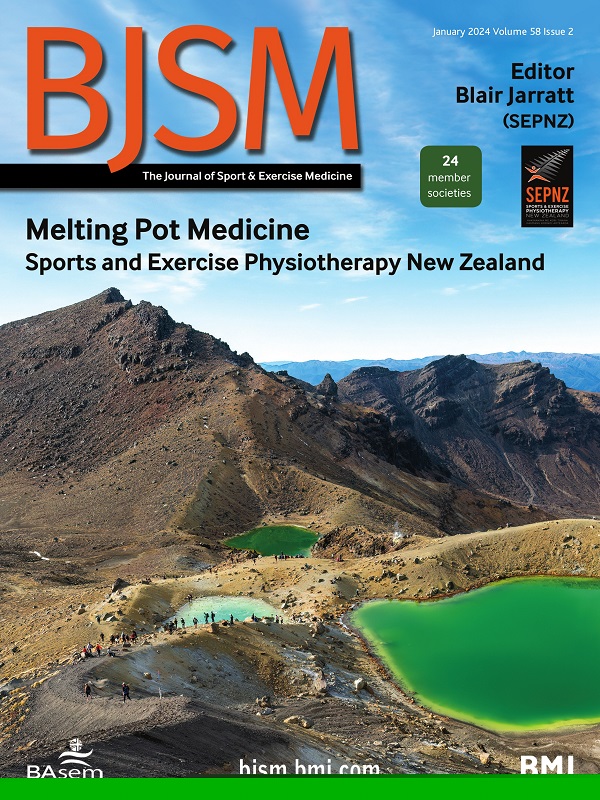机器学习方法在运动损伤风险预测:与证据合成的范围审查
IF 11.6
1区 医学
Q1 SPORT SCIENCES
引用次数: 0
摘要
目的综述机器学习(ML)在运动损伤预测中的研究现状。在建立预测模型时,考虑到数据异质性、模型特异性和背景因素等因素,旨在绘制所使用的各种方法的图表并评估其有效性。设计范围审查。数据来源PubMed, EMBASE, SportDiscus和IEEEXplore。结果共纳入1241项研究,筛选了58篇全文,回顾并绘制了38项相关研究的图表。足球是最常被调查的运动。曲线下面积(AUC)是最常用的模型评价手段;71%的研究报告了这一点。在60%的研究中,基于树的解决方案提供了最高的统计预测性能。随机森林和极端梯度增强(XGBoost)在损伤风险预测方面提供了最高的性能。在12项研究中有4项,逻辑回归优于ML方法。三项研究报告了AUC >.9的模型性能,但临床相关性值得怀疑。结论多种不同的ML模型已被应用于运动相关损伤的预测。虽然有几项研究报告了强有力的预测性能,但它们的临床应用可能有限,预测窗口宽或损伤定义宽泛。ML的疗效受到小数据集和众多方法异质性(队列大小、损伤定义和因变量)的阻碍,这些在所回顾的研究中很常见。所有与研究相关的数据都包含在文章中或作为补充信息上传。本文章由计算机程序翻译,如有差异,请以英文原文为准。
Machine learning approaches to injury risk prediction in sport: a scoping review with evidence synthesis
Objective This study reviewed the current state of machine learning (ML) research for the prediction of sports-related injuries. It aimed to chart the various approaches used and assess their efficacy, considering factors such as data heterogeneity, model specificity and contextual factors when developing predictive models. Design Scoping review. Data sources PubMed, EMBASE, SportDiscus and IEEEXplore. Results In total, 1241 studies were identified, 58 full texts were screened, and 38 relevant studies were reviewed and charted. Football (soccer) was the most commonly investigated sport. Area under the curve (AUC) was the most common means of model evaluation; it was reported in 71% of studies. In 60% of studies, tree-based solutions provided the highest statistical predictive performance. Random Forest and Extreme Gradient Boosting (XGBoost) were found to provide the highest performance for injury risk prediction. Logistic regression outperformed ML methods in 4 out of 12 studies. Three studies reported model performance of AUC>0.9, yet the clinical relevance is questionable. Conclusions A variety of different ML models have been applied to the prediction of sports-related injuries. While several studies report strong predictive performance, their clinical utility can be limited, with wide prediction windows or broad definitions of injury. The efficacy of ML is hampered by small datasets and numerous methodological heterogeneities (cohort sizes, definition of injury and dependent variables), which were common across the reviewed studies. All data relevant to the study are included in the article or uploaded as supplementary information.
求助全文
通过发布文献求助,成功后即可免费获取论文全文。
去求助
来源期刊
CiteScore
27.10
自引率
4.90%
发文量
217
审稿时长
3-8 weeks
期刊介绍:
The British Journal of Sports Medicine (BJSM) is a dynamic platform that presents groundbreaking research, thought-provoking reviews, and meaningful discussions on sport and exercise medicine. Our focus encompasses various clinically-relevant aspects such as physiotherapy, physical therapy, and rehabilitation. With an aim to foster innovation, education, and knowledge translation, we strive to bridge the gap between research and practical implementation in the field. Our multi-media approach, including web, print, video, and audio resources, along with our active presence on social media, connects a global community of healthcare professionals dedicated to treating active individuals.

 求助内容:
求助内容: 应助结果提醒方式:
应助结果提醒方式:


